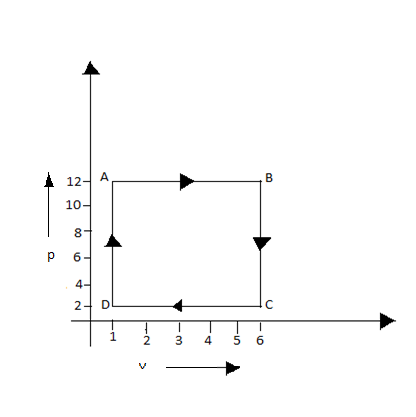
The diagram shown is a P-V graph of thermodynamic behavior of an ideal gas. Find out from this graph (I) work done in the process A




Answer
495.6k+ views
1 likes
Hint: Work done is defined by the product of pressure exerted and change in volume. Therefore the work done is given as: W = P
Where, p is pressure and
Complete step by step answer:
The work done is given by W = P
- If the process is expansion the work done by gas will give negative sign convention.
W = - P
-If the process is contraction the work done on gas will give a positive sign convention.
W = + P
Let's solve the problem
(i) - Work done in process A
W = - P
= - (
= -6000J
- Work done in process B
- Work done in process C
W = + P
= + (
= 1000J
- Work done process D
(ii) the work done in complete cycle = sum of work done in process A
= 6000J + 0J + 1000J + 0J
= 7000J
Thus the work done in complete cycle is 7000J
So, the correct answer is “Option B”.
Note: If the process is expansion the work done is by gas so the sign convention is negative as, when work is done by the gas some energy is let out. If the process is contraction the work done is on gas so the sign convention is positive as, when work is done on the system there will be addition of energy to the system.
Where, p is pressure and
Complete step by step answer:
The work done is given by W = P
- If the process is expansion the work done by gas will give negative sign convention.
W = - P
-If the process is contraction the work done on gas will give a positive sign convention.
W = + P
Let's solve the problem
(i) - Work done in process A
W = - P
= - (
= -6000J
- Work done in process B
- Work done in process C
W = + P
= + (
= 1000J
- Work done process D
(ii) the work done in complete cycle = sum of work done in process A
= 6000J + 0J + 1000J + 0J
= 7000J
Thus the work done in complete cycle is 7000J
So, the correct answer is “Option B”.
Note: If the process is expansion the work done is by gas so the sign convention is negative as, when work is done by the gas some energy is let out. If the process is contraction the work done is on gas so the sign convention is positive as, when work is done on the system there will be addition of energy to the system.
Latest Vedantu courses for you
Grade 11 Science PCM | CBSE | SCHOOL | English
CBSE (2025-26)
School Full course for CBSE students
₹41,848 per year
EMI starts from ₹3,487.34 per month
Recently Updated Pages
Master Class 11 Economics: Engaging Questions & Answers for Success

Master Class 11 Business Studies: Engaging Questions & Answers for Success

Master Class 11 Accountancy: Engaging Questions & Answers for Success

Master Class 11 English: Engaging Questions & Answers for Success

Master Class 11 Computer Science: Engaging Questions & Answers for Success

Master Class 11 Maths: Engaging Questions & Answers for Success

Trending doubts
State and prove Bernoullis theorem class 11 physics CBSE

1 ton equals to A 100 kg B 1000 kg C 10 kg D 10000 class 11 physics CBSE

State the laws of reflection of light

One Metric ton is equal to kg A 10000 B 1000 C 100 class 11 physics CBSE

1 Quintal is equal to a 110 kg b 10 kg c 100kg d 1000 class 11 physics CBSE

Difference Between Prokaryotic Cells and Eukaryotic Cells




